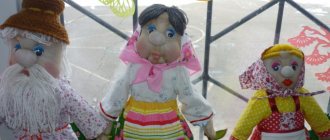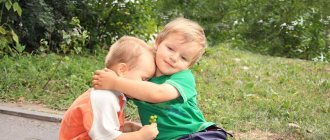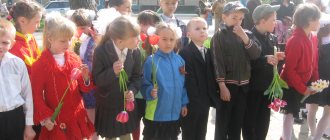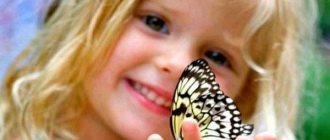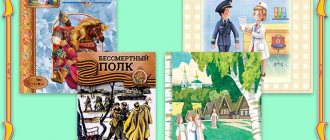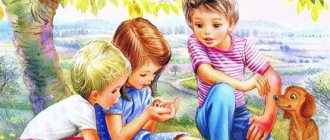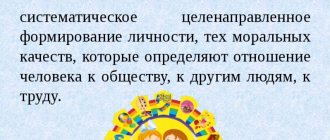We all come from childhood. Almost everyone listened to bedtime stories and imagined themselves as participants in magical adventures - the girls were fairies and princesses, the boys were the constant winners of dragons and all sorts of goblin-ghouls. But we hardly thought then that a fairy tale was a very important (if not the main!) element of our upbringing and the system of our ideas about the world, about good and evil, about work and “rewards” for laziness.
Now, sitting on the other side of the crib, it’s worth figuring out what a fairy tale is from a scientific point of view and how you can help your baby in temporary age-related or stressful situations, how can a fairy tale “cure” greed, enuresis, and fear of the dark?
So, welcome to the magical world of the fairy “wrong side”!
Where did the idea of education through fairy tales come from?
Classic of Russian pedagogy K.D. Ushinsky wrote that fairy tales are “the first and brilliant attempts of Russian folk pedagogy, and I don’t think anyone would be able to compete in this case with the pedagogical genius of the people.” The same opinion was shared by the researcher of Russian folklore V.P. Anikin, who said that “in the thought that gives life to fairy tales, the multifaceted mind of the people was manifested, their history, life, and worldview were deposited in crystals.”
One cannot argue with the value of fairy tales also because they begin to be read to children at an age when children are just beginning to form the rudiments of morality, goodwill, integrity and hard work.
A fairy tale, passing through centuries of folk wisdom, like a snowball accumulates all the most valuable things for children's preschool pedagogy. This is a unique way to raise a child not with the help of exhortations and abstract judgments, but with the help of direct experience and the actions of heroes who may or may not be loved, but are still very significant for the child. It is only important to manage this treasure wisely.
Currently, despite the obvious interest in fairy tales as an educational “tool,” there are many difficulties - the lack of consistency entails the lack of methods of pedagogical influence, and, therefore, affects the effectiveness of the pedagogical use of fairy tales. To this day, some teachers and educators find it difficult to imagine that, from the point of view of educating moral attitudes, the potential of a fairy tale is much more serious than its artistic and historical significance.
Currently, we are increasingly seeing examples of children's cruelty and aggressiveness towards each other, towards loved ones. Under the influence of far from moral cartoons, children have distorted ideas about moral qualities: kindness, mercy, justice. From birth, a child is aimed at the ideal of good, so I believe that from early preschool age it is necessary to show the child the moral essence of every action.
Knowing the age characteristics of children in the 5th year of life, I noticed that not all children know how to communicate with each other, some show a tendency towards hostility, reluctance to share toys, or help a friend in a difficult situation. Children have poorly developed skills of sympathy and empathy. Namely, from an early age the formation and development of a person’s moral qualities begins.
To solve this problem, I chose to introduce children to Russian folk tales, since I believe that fairy tales have firmly entered the child’s life, and in their essence, a fairy tale fully corresponds to the nature of a small child; close to his thinking and ideas.
Based on this, I set myself a goal:
To develop and nurture spirituality and feelings in the soul of every child, so that he does not grow up to be a soulless, indifferent person.
To achieve the goal, I identified the following tasks:
- Encourage children's interest in Russian folk tales.
- Create the necessary conditions for children to become acquainted with Russian folk tales.
- To form an idea of good and evil, to show the beauty of good deeds and their necessity in people’s lives.
- Develop the ability to think, compare, analyze the actions of fairy-tale characters, learn to evaluate the behavior of your own and others.
- Select diagnostic materials aimed at monitoring the level of education of children’s moral qualities using the example of heroes of Russian folk tales.
- To help parents understand the value of a fairy tale, its special role in the education of today’s and especially tomorrow’s people.
Methods for introducing preschoolers to fairy tales
The most common method of introducing a fairy tale is reading by the teacher, i.e. verbatim transmission of the text. I tell the children by heart fairy tales that are small in volume, because this achieves the best contact with the children. I read most of my works from books. Handling a book with care while reading is an example for children.
The next method is storytelling, i.e. more fluent text transmission.
When telling, shortening the text, rearranging words, including explanations, and so on are allowed. The main thing in a storyteller’s presentation is to tell the story expressively so that the children listen.
To consolidate knowledge, methods such as didactic games based on familiar fairy tales and literary quizzes are useful.
Examples of didactic games include the games “Guess my fairy tale”, “One starts - the other continues”, “Where am I from?” (description of heroes) and others.
I conduct literary quizzes as final quarterly classes or evening entertainment.
Techniques for forming the perception of a fairy tale
Expressiveness of reading.
The main thing is to read it expressively so that the children listen. Expressiveness is achieved by a variety of intonations, facial expressions, sometimes a gesture, a hint of movement. All these techniques are aimed at ensuring that children imagine a living image.
The next technique is repeated reading. It is advisable to repeat a short fairy tale that aroused the interest of children. From the big fairy tale, you can read the most significant and vivid passages again. Repeated reading and storytelling can be combined with drawing and modeling. The artistic word helps the child create visual images, which the children then recreate.
One of the techniques that contributes to better assimilation of the text is selective reading (excerpts, songs, endings).
You can ask a number of questions (What fairy tale is this excerpt from? From a story or fairy tale is this excerpt? How did this fairy tale end?
If after the first reading the fairy tale is already understood by the children, the teacher can use a number of additional techniques that will enhance the emotional impact - showing toys, illustrations, pictures, elements of dramatization, movements of fingers and hands.
Dramatization is one of the forms of active perception of a fairy tale. In it, the child plays the role of a fairy-tale character.
Involving children in dramatization. Dramatization helps to develop such character traits as courage, self-confidence, independence, and artistry.
You can use verbal techniques. Children often do not understand some words or expressions. In such cases, it is necessary to give them the opportunity to understand a new word and construct phrases by comprehending the situation. As a rule, you should not interrupt reading by explaining individual words and expressions, as this disrupts the perception of the work. This can be done before reading.
A widely used technique that enhances the impact of a text and promotes better understanding is looking at the illustrations in a book.
The illustrations are shown to children in the sequence in which they are placed in the fairy tale, but after reading.
The next technique is a conversation based on a fairy tale. This is a complex technique, often including a number of simple techniques - verbal and visual. There is a distinction between an introductory (preliminary) conversation before reading and a short (final) conversation after reading.
During the final conversation, it is important to focus children’s attention on the moral qualities of the heroes and the motives of their actions.
Conversations should be dominated by questions the answer to which would require motivation for assessments.
Stages of working with a fairy tale
- Ø Introducing children to Russian folk tales - reading, storytelling, conversations about the content, looking at illustrations - in order to develop an emotional attitude towards the actions and characters of the fairy tale.
- Ø Emotional perception of fairy tales by children - children’s retelling of the content of the fairy tale, table theater, outdoor games with fairy tale characters - in order to consolidate the content of fairy tales. These forms of working on a fairy tale allow you to find out how children understood the essence of the fairy tale.
- Ø Artistic activities - attitude towards the hero of a fairy tale in modeling, drawing, appliqué, design - allow children to express their attitude towards the heroes of a fairy tale, embody their experiences, develop skills of empathy, sympathy for the fate and actions of the heroes of a fairy tale.
- Ø Preparation for independent activities - acting out scenes from fairy tales, theatrical games, dramatization of fairy tales, creative play using characters, plots from fairy tales - the method of turning children into heroes of fairy tales contributes not only to the development of sympathy, but also to understanding the moral lessons of fairy tales, the ability to evaluate actions not only the heroes of the fairy tale, but also the people around them.
In order to solve the problems, I divided my work into stages, using the integrative method:
Preparatory stage:
- Selection and study of methodological literature;
- Selection of didactic games
- Made a long-term plan
- Developed a cyclogram on the theme “A week with goodness in the heart”
Main stage or implementation stage
Working together with parents.
We held a parent meeting “The fairy tale is a lie - but there is a hint in it...” (introduced them to the subject-developmental environment of the group, made a plan for visiting theater Fridays.)
Parents were informed about what fairy tales are included in the reading range of children of the 5th year of life. We present information in the corner for parents in the form of lists of literary works indicating what we will read in kindergarten and what is recommended for reading at home.
In the corner for parents we place advice and suggestions on how to organize a child’s reading at home, under the following headings: “Your child’s personal library”, “Fairy tales in a child’s life”, “How and when to tell fairy tales”, “What and how to talk to children after reading”; “Books and theater”, “Folk tales”, “Reading and playing”, “Drawing a fairy tale”, etc.
We conducted individual consultations and conversations with parents on the topics: “How to make friends with books”, “Features of reading fairy tales about animals”, “Fairy tales as a means of moral education of a child”, “Education and books”.
Together with the parents, we replenished the group’s library with new colorful books with Russian folk tales, listening discs, and parents who still had books from their childhood brought them to the group, replenished the theater corner with a finger theater made of threads for all Russian folk tales according to our age. We carried out the project “Do-it-yourself book”
Leisure activities for children on literary topics prepared together with parents are very useful: the quiz game “Away with Fairy Tales”, “What?, Where?, When?”, “In the Land of Good and Evil”
Together with parents, we organize exhibitions of works by children and parents: “Our Favorite Fairy Tales”, “Winter Tales”, “Colored Fairy Tales”.
On Mother’s Day, they organized a competition “Grandma’s Pie” and for all the guests the children showed the fairy tale “Where are you, affectionate mother?” For the holiday of March 8 they showed the fairy tale “Kolobok in a new way” - the fairy tale was remade together with the children.
We carried out the project “Do-It-Yourself Book”
Thus, I carry out all the work on developing moral qualities in preschoolers through fairy tales together with their parents.
Work with children.
The group had a number of entertainments: on Mother’s Day they organized a competition “Granny’s Pie” and for all the guests the children showed the fairy tale “Where are you, affectionate mother?”, for the holiday of March 8 they showed the fairy tale “Kolobok in a new way” - the fairy tale was remade together with the children, by February 23, dads were told a fairy tale with a new ending, “The Wolf and the Seven Little Goats”
Fairy tale in the system of moral education
It is advisable to form such moral categories as good and evil, good and bad, possible and impossible, by your own example, as well as with the help of folk tales, including those about animals. These tales will help the teacher show: • how friendship helps defeat evil (“Zimovye”); • how the good and peace-loving ones win (“The Wolf and the Seven Little Goats”); • that the evil fairy tale does not give direct instructions to children (such as “Listen to your parents,” “Respect your elders,” “Don’t leave home without permission”), but its content always contains a lesson that they gradually perceive, repeatedly returning to the text of the fairy tale.
For example, the fairy tale “Turnip” teaches younger preschoolers to be friendly and hardworking; the fairy tale “Masha and the Bear” warns: you can’t go into the forest alone - you can get into trouble, and if this happens, don’t despair, try to find a way out of a difficult situation; fairy tales “Teremok” and “Winter Quarters of Animals” teach how to be friends. The order to obey parents and elders is heard in the fairy tales “Geese and Swans”, “Sister Alyonushka and Brother Ivanushka”, “Snow Maiden”, “Tereshechka”. Fear and cowardice are ridiculed in the fairy tale “Fear Has Big Eyes”; cunning is ridiculed in the fairy tales “The Fox and the Crane”, “The Fox and the Black Grouse”, “Sister Fox and the Gray Wolf”, etc. Hard work in folk tales is always rewarded (“Khavroshechka”, “Moroz Ivanovich”, “The Frog Princess”), wisdom is praised (“The Man and the Bear”, “How a Man Divided Geese”, “The Fox and the Goat”), caring for loved ones is encouraged (“Bean Seed”).
The final stage
I selected diagnostic material for monitoring the level of education of children’s moral qualities using the example of heroes of Russian folk tales: N.V. Nizhegorodtseva’s diagnosis “Moral Ladder”, criteria for determining the responsiveness of children using problem situations.
At the end of May we are planning to hold an open day in the group; we have prepared a theatrical fairy tale “Home for Friends” based on the Russian folk tale “Teremok” with the participation of all children.
Result :
— Children learned to understand the meaning of fairy tales
- To distinguish good from evil, good or bad, possible or impossible
— Children have become less shy, they choose any role without fear,
— There was mutual understanding thanks to the joint work of children and parents;
— There was a dynamic in the relationship with parents, they began to take part in the preparation of holidays and exhibitions; parent meetings began to take place in a warmer environment.
Conclusion:
The value of fairy tales lies in their influence on the comprehensive development of the child, and especially on moral education.
Fairy tales inspire confidence in the triumph of truth and the victory of good over evil. As a rule, the suffering of a positive hero and his friends is transient, temporary, and they are usually followed by joy, and this joy is the result of struggle, the result of joint efforts.
In order for a child to grow up to be a good person, it is necessary to work with him, starting from early childhood. Fairy tales help revive spirituality, mercy, and humanity in people. And we need to start with children, since the material side of life has already captured them in its networks.
Children can still sympathize and empathize. The task of a preschool institution is not to let these sprouts be crushed by the reality of a harsh life, but to do everything necessary so that they sprout, sprouted deeply in the soul and heart of the child. The main means of education is literature for children, fairy tales that turn human hearts to kindness, generosity, conscience, honor and justice. A child's personality begins in childhood. Therefore, the sooner literature, namely a fairy tale, touches the strings of a child’s soul, and not just the mind, the more guarantees there are that good feelings will prevail in them over evil ones. After all, literature is a pounding heart that speaks in the language of feelings.
From all this it follows: moral education is possible through all types of fairy tales, because morality is initially inherent in their plot.
How to read a fairy tale with a child
The main goal of discussing fairy tales is to build a connection between the behavior of the characters, the events occurring in the fairy tale and the real-life situations that the child faces. In this case, the plot of the fairy tale is transformed for the child into a personal store of knowledge and ideas, which he can turn to if necessary, for example, if he finds himself in some difficult situation. The famous fairytale therapist Tatyana Zinkevich-Evstigneeva suggests using the following scheme for discussing fairy tales:
A fairy tale is a lie, but there is a hint in it...
Discuss with your child what the fairy tale is about and what it teaches. Ask, in what situations in real life can what a child learned from a fairy tale be useful?
Baba Yaga vs. beautiful girl
Discuss the heroes of the fairy tale. Why does the hero perform this or that action? Why does he need this? What did he really want?
Fire, water and copper pipes
Talk about how the heroes of the fairy tale overcame difficulties. Did they turn to anyone for help? Perhaps someday your child will be able to use these methods in real life.
...a lesson to good fellows!
What feelings does this fairy tale evoke? Which episodes were particularly memorable? What episodes evoked joyful feelings? Which ones are sad? What situations caused fear?
Using the same scheme, you can discuss with your child the feature and animated films you watched together.
How to compose a fairy tale with your child
By writing fairy tales with your child, you can touch his inner world, learn about what worries him, scares him, or, on the contrary, inspires and supports him. The plot of a fairy tale is built according to certain canons: in essence, it is a sequence of events united by a certain plot.
Start by creating a main character. Give him a name and image. You can also involve art therapy here - draw a hero or sculpt him from plasticine. Find out from your child what qualities the hero has, what his character is. Discuss what your story will be about. Typically, the main character has a goal and there are obstacles to achieving it. Also in the fairy tale there are hero-allies and hero-opponents. In the process of creating a plot, try to draw parallels with the child’s real life: ask how this relates to his experience and experiences, why did he choose such a goal and such tests for the hero?
How to come up with new endings to existing fairy tales
Sometimes, in order to help a child find a solution to a problem through a fairy tale, you don’t need to compose a new one. It is enough to come up with a new ending to one of those that already exists. Here it is important to choose a fairy tale whose key problem will coincide with the one that is currently relevant for the child. For example, if a child is worried about a strict teacher who gives a lot of tasks or gives low grades, you can discuss the fairy tale about Cinderella with him.
In fairy tales, magic often comes to the aid of the main character. Cinderella, for example, is protected from her stepmother by her fairy godmother. How could Cinderella cope on her own, without magical help? Was her stepmother so unfair to her, since Cinderella herself ran away without completing the “homework” left to her? Did Cinderella have any options to negotiate with her stepmother?
So, with the help of fairy tale therapy, you can help your child change his attitude towards a situation that he experiences as hopeless or unfair. With your help, he will learn to look at the problem from different angles, look for options and not feel small and helpless.
Anna Kolchugina
Does your child believe in miracles? Find out together! TAKE THE TEST!
How fairy tales can be useful to parents
Fairy tales for children are not only an exciting journey into the world of fictional characters. Through fairy tales, children receive their first knowledge about the structure of life. At first glance, the world of fairy tales may seem black and white, with a clear division into good and evil. However, if we look deeper, fairy tales can also teach children a broader view of events and people. For example, the troubles and trials that befall the hero ultimately help him become stronger and more resourceful and lead to some desired changes. And sometimes in fairy tales there are ambiguous characters who, at first glance, behave like villains, and then are revealed - it is discovered that there are some reasons behind their behavior, or it was not villainous at all, but ultimately helped the hero.
Few parents know that fairy tale therapy can trigger the body’s self-regulation mechanisms. Blogger I am a Parent, clinical psychologist and certified fairytale therapist Ekaterina Blukhterova brings to your attention the therapeutic fairy tale “The Good Forest”: it will help your child find the inner strength for a speedy recovery.
